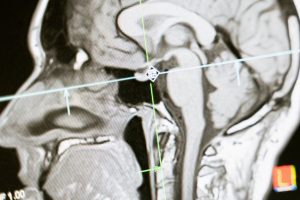Acoustic Neuroma
1. What is Acoustic Neuroma?
An acoustic neuroma, also known as a vestibular schwannoma, is a benign, slow-growing tumor that develops on the vestibular nerve, responsible for balance and hearing. Although non-cancerous, its location near critical structures within the skull can lead to various symptoms and complications.

2. What are the causes?

The exact cause of acoustic neuromas remains unclear. However, most cases are associated with a genetic mutation on chromosome 22, leading to the abnormal growth of Schwann cells that form the insulating sheath around nerves. Over time, these overgrown Schwann cells create the tumor.
3. How Common is Acoustic Neuroma?
Acoustic neuromas are relatively rare, accounting for about 8% of all tumors inside the skull. They typically affect
adults between the ages of 30 and 60, though they can occur at any age. The condition is more common in women than in men.
4. What can an ENT Specialist do for you?
An ENT specialist plays a pivotal role in the diagnosis, management, and treatment of acoustic neuromas.
They provide the following services :
ENT specialists employ various tests, including audiometry, magnetic resonance imaging (MRI),and auditory brainstem response (ABR) testing, to confirm the presence and size of the tumor.
Once diagnosed, the specialist discusses treatment options and assists patients in making informed decisions based on factors like tumor size, hearing status, and overall health.
In cases where the tumor is causing significant symptoms, is large, or is growing rapidly, surgical removal may be recommended.
For smaller tumors or when surgery is not suitable, an ENT specialist may recommend watchful waiting (observation), radiation therapy, or other non-invasive treatments.
5. How Can Acoustic Neuroma Be Treated?
The treatment approach for acoustic neuroma depends on several factors, including tumor size, patient age,overall health, and extent of hearing loss.
Common treatment options include :

Observation (Watchful Waiting)
For small and slow-growing tumors that do not cause significant symptoms, regular monitoring with MRI scans may be recommended to track the tumor’s progress.

Surgery
Surgical removal of the tumor, known as microsurgical resection, is often recommended for larger tumors or when hearing loss is severe. Various surgical techniques can be employed to remove the tumor while preserving facial nerve function.
- Translabyrinthine Approach : This surgical method involves entering the inner ear to access and remove the tumor. While it sacrifices hearing in the affected ear, it’s an effective option for larger tumors.
- Retrosigmoid Approach : This approach involves accessing the tumor from behind the ear and offers better preservation of hearing and facial nerve function.

Radiation Therapy
Stereotactic radiosurgery (e.g., Gamma Knife or CyberKnife) can be used to target and shrink the tumor with high-dose radiation. This option is suitable for some patients, especially those who may not be candidates for surgery.
6. Guidelines for Surgery
- Detailed preoperative evaluations, including imaging and hearing tests, are conducted.
- Surgical planning considers the tumor’s size, location, and proximity to critical structures.
- Various surgical approaches, such as translabyrinthine or retrosigmoid, are chosen based on the individual case.
- Postoperative care includes monitoring for complications and providing rehabilitation as needed.
7. Evaluation & Follow Up for Treatment
Following treatment, regular follow-up appointments are essential to monitor the patient’s progress, hearing function, and any potential recurrence of the tumor.
RISKS OF SURGERY :
While surgery can be highly effective in removing the tumor, it carries certain risks, including infection, hearing loss, facial nerve damage, and cerebrospinal fluid leakage. The specific risks depend on the tumor’s size and location and the patient’s overall health.
Alternatives to Surgery:
For patients who are not suitable candidates for surgery or prefer non-invasive options, radiation therapy and observation (watchful waiting) are viable alternatives. These approaches aim to control tumor growth and preserve hearing when possible.
In conclusion, acoustic neuromas are rare, benign tumors that affect hearing and balance. An ENT specialist plays a crucial role in diagnosing and managing this condition, offering various treatment options tailored to individual cases. Treatment decisions are made based on factors like tumor size, hearing status, and the patient’s overall health. Surgical options include the translabyrinthine approach, which sacrifices hearing but is effective for larger tumors, and the retrosigmoid approach, which offers better preservation of hearing and facial nerve function. Regular post-treatment follow-ups are essential to ensure the best possible outcomes for patients.
Evaluation & Follow Up for Treatment
After surgery or other treatments, regular follow-up appointments with the ENT specialist are essential. These visits allow for the monitoring of healing, hearing function, and the detection of any potential recurrence.
RISKS OF SURGERY :
Ear tumour surgery, like any surgical procedure, carries inherent risks, including infection, bleeding, changes in hearing, and damage to surrounding structures. However, these risks are typically minimized when performed by experienced ENT surgeons.
ALTERNATIVES TO SURGERY :
In some cases, especially with small benign tumours, observation without immediate surgical intervention may be an option. Your ENT specialist will discuss the pros and cons of non-surgical approaches.
In conclusion, ear tumours, though rare, require prompt diagnosis and treatment by ENT specialists to preserve hearing, balance, and overall ear health. The choice of treatment depends on the type and stage of the tumour, with surgery being a common and effective approach. If you suspect you may have an ear tumour or are experiencing symptoms such as hearing loss or dizziness, consult with an ENT specialist for a thorough evaluation and personalized treatment plan.
